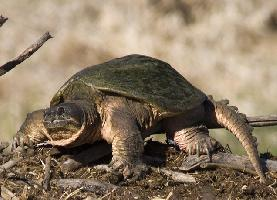
Weights and measures
| Length | 140 cm |
|---|---|
| Weight | 100 kg |
Biological data
| Lifespan | 50 r |
|---|
Animal description
The Alligator Snapping Turtle (Macrochelys temminckii) is a prehistoric-looking reptile that is often considered one of the most formidable freshwater turtles in the world. This species is native to the southeastern United States and is particularly found in river systems that drain into the Gulf of Mexico. It is known for its large size, powerful jaw, and distinct physical characteristics.An adult Alligator Snapping Turtle can have a carapace, or shell, that measures up to 26 inches (66 cm) in length, with males typically being larger than females. They can weigh anywhere from 70 to over 200 pounds (32 to 91 kg), with the largest individuals on record exceeding this range significantly. The carapace is rugged and ridged, with three distinct rows of spike-like keels running down its length, giving it a primitive, dinosaur-like appearance that is the basis for its common name.
The coloration of the Alligator Snapping Turtle's shell can vary from brown to black, often covered with algae which provides excellent camouflage among the waterlogged vegetation of its habitat. Its plastron, or the underside of the shell, is relatively small and leaves much of the limbs and neck exposed. The skin of the turtle is thick, rough, and typically matches the color of its shell, and its limbs are muscular with large, scaled, clawed feet that are well-adapted for walking along the bottom of water bodies.
One of the most distinctive features of the Alligator Snapping Turtle is its massive head and powerful beak-like jaws, which are capable of snapping with incredible force. This, combined with the turtle's sheer size, makes it a formidable predator. Within its mouth, there is a small, worm-like appendage on the floor of the mouth, which is a specialized lingual lure used for fishing; the turtle can wiggle this appendage to attract curious fish or other prey within reach of its deadly jaws.
The Alligator Snapping Turtle is a primarily aquatic species that prefers the deep waters of large rivers, swamps, and bayous. It is not a fast swimmer, instead relying on stealth and its excellent camouflage to catch prey. It is mostly nocturnal and spends the majority of its time lying motionless in the water, waiting to ambush its prey, which includes fish, frogs, snakes, smaller turtles, birds, and even small mammals.
Reproduction in Alligator Snapping Turtles involves the female laying a clutch of 10 to 50 eggs in a nest dug into the ground, often far from the water's edge. The eggs incubate for about 100 to 140 days before hatching. Juvenile turtles are independent from birth and receive no parental care, facing a host of predators that they will not have to worry about once they reach their impressive adult size.
Alligator Snapping Turtles have a slow metabolism and can live for many decades, with some individuals believed to be over 100 years old. However, due to habitat destruction, pollution, overharvesting for their meat, and the pet trade, their populations have declined, and they are considered a species of conservation concern. They are protected under state and federal laws in the United States, and efforts are being made to conserve their habitats and manage their populations sustainably.
Similar Animals
New photos of animals
Top 10 animals
- Dolphin gull (Leucophaeus scoresbii)
- Diana monkey (Cercopithecus diana)
- Moustached guenon (Cercopithecus cephus)
- Galápagos tortoise (Geochelone nigra complex)
- Japanese macaque (Macaca fuscata)
- Russian tortoise (Testudo horsfieldii)
- Stone loach (Barbatula barbatula)
- Greek tortoise (Testudo graeca)
- Common flying dragon (Draco volans)
- Vendace (Coregonus albula)
